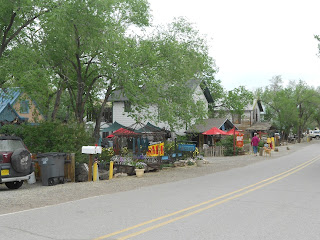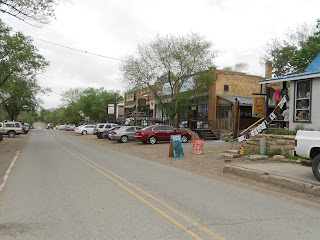 |
| Shops line the streets in Madrid, NM |
Madrid New Mexico has a history dating back to the 1800's and had everything to do with coal mining. This wasn't any coal mining area. Madrid had the distinction of being one of only three areas of the world where mining of both soft and hard coal could be accomplished. Soft coal by definition is a bituminous coal that burns readily with a yellow flame. Soft coal was in demand for a growing nation and it's railroads.
Mine shafts at Madrid could go some 2,500 feet under ground. Under ground mining is an expensive proposition. Coal mining was great for the local economy because there was large need very nearby. The consumers were the Atchison Topeka & Santa Fe Railroad, the U.S. government and of course the local towns.
Madrid New Mexico went from a booming coal mining town to a ghost town and now to an art and culture destination. Today, Madrid is a booming tourist attraction on NM Rte 14. Starting in the 1970's artists and craftspeople arrived and today you'll find many fine galleries, shops, restaurants and museums. Madrid is an absolutely delightful destination. Regular art and entertainment events are scheduled in Madrid that brings people there from all over the country.
The first Europeans in this region of New Mexico were the Spaniards. Santa Fe, just about 15 miles to the north was officially established in 1610. At that time the area of Madrid and the Turquoise Trail were largely inhabited by Indians.
Valuable Turquoise Deposits
 |
| NM Rte 14 through Madrid, New Mexico |
The population in this area just to the northeast of the Sandia Mountains remained sparse however some farming was taking place.
Coal Becomes King
It wasn't until a century or two later that the entire area on the Turquoise Trail and Madrid in particular would take off. Coal mining became THE industry in Madrid starting around 1835. This would have been during the short span of Mexican rule which lasted from about 1821 to 1846. If the massive coal deposits weren't enough to put Madrid New Mexico (at the time Nuevo Mexico) on the map, placer gold deposits were found there in about 1840.
Madrid reached it's high point starting in the 1880's. Just as in the case of other mining towns spread all over the west, Madrid New Mexico, because of it's underground mining industry, had one of the largest populations in New Mexico. For another example, there was a time when Virginia City Nevada was the largest town in the territory. In the 1890's Madrid claimed more than 3,000 residents making it a larger town than Albuquerque. The Atchison Topeka & Santa Fe Railroad was a good customer for the towns coal production and even built a spur line down to Madrid from it's main line.
Twentieth Century Coal Mining
 |
| AT & SF Railroad steam locomotive |
The photo left is of an old Atchison Topeka & Santa Fe Railroad 2-8-0 configuration steam locomotive used in Madrid. This particular steam locomotive was built in the year 1900 by the Richmond Locomotive Works.
This old steam engine is on display at the Old Coal Mine Museum in Madrid. The Atchison Topeka & Santa Fe was vital in the growth of New Mexico during the late 1800's and early 1900's.
The coal company provided everything it's employees would need to live and work in Madrid. Churches, shops, auto garages and even a jail. Eventually the Albuquerque and Cerrillos company was bought by one of it's employees, Oscar Huber. Huber started working for the mining company in 1910 and became general supervisor. Interestingly enough, when Huber joined the company there was electricity available. It was generated by a company owned powerhouse but was used only by the company.
If you had a home in Madrid, you used candles or oil and gas lights. By about 1915, after Huber had acquired the coal company, electricity was available for residential use. The electricity use in Madrid in 1915 was still pretty unique for a remote town. As an example, parts of the Texas Hill Country west of Austin was without electricity until the year 1938, some 23 years after the coal town of Madrid. The Hill Country was filled with ranches and farms and running electric lines there was considered too expensive, thus the delay. In the case of Madrid New Mexico, the booming coal industry made it economically feasible to generate electricity. They had their own powerhouse. As for it's use by residents, it would take Oscar Huber's ownership to make electricity available.
Oscar Huber Builds Madrid
Huber did much more than provide electricity. He is credited with paving Madrid's streets and building a six room hospital. Huber also built homes on vacant lots. Madrid's stature in New Mexico was enhanced when, during the 1920's and 1930's, the town became famous for it's Christmas lights display. People would come from all over New Mexico to see the lights.
Beginning in the 1920's, the town miners lit up the town at Christmas time with some 150,000 lights. This was made possible in part by the coal company's coal fed electric generators. The electricity and the coal were there so the miners used their resources to make the company town of Madrid a Christmas destination.
Change Comes
 |
| Engineer's controls on the AT & SF steam locomotive |
Manpower was a short supply with the U.S. military taking many of the miners. There was also a move to different power sources than coal, such as gas and diesel. The coal consumption dwindled for years until by 1954 there was almost nobody left in Madrid.
The town was actually put on the selling block with an asking price of $250,000. There were no takers. The old company town, now a ghost town, was eventually owned by Joe Huber, the son of the Albuquerque and Cerrillos supervisor and later owner of the company. Madrid stayed a ghost town for many years. It wouldn't be until the 1970's that new life and new interest came to Madrid.
The New madrid New Mexico
In the 1970's, the first arrivals were hippies looking for a place to stay. Huber rented out some of the structures to the new arrivals and things pretty much grew from there.
Artists and craftsmen emigrated to the area where they would eventually set up galleries. The tourism industry started to grow and with it so did Madrid. Being located between the tourist destination of Santa Fe and the states largest city, Albuquerque, didn't hurt. Also being located in the heart of northern New Mexico's art region is a big plus. Today the Turquoise Trail is a favorite route for many driving between the two cities. The approximately 300 people who call Madrid home today have even reintroduced the Christmas lights display that the town had been much noted for during it's glory years.
Two articles on additional travel stops in northern New Mexico are Bandelier National Monument northwest of Santa Fe near Los Alamos and the Oldest Church in the U.S. in Santa Fe.
If you're planning a New Mexico road trip vacation, a drive on the scenic Turquoise Trail between Albuquerque and Santa Fe is a lot of fun with great photo opportunities.
(Article and photos copyright Western Trips)
View Larger Map

